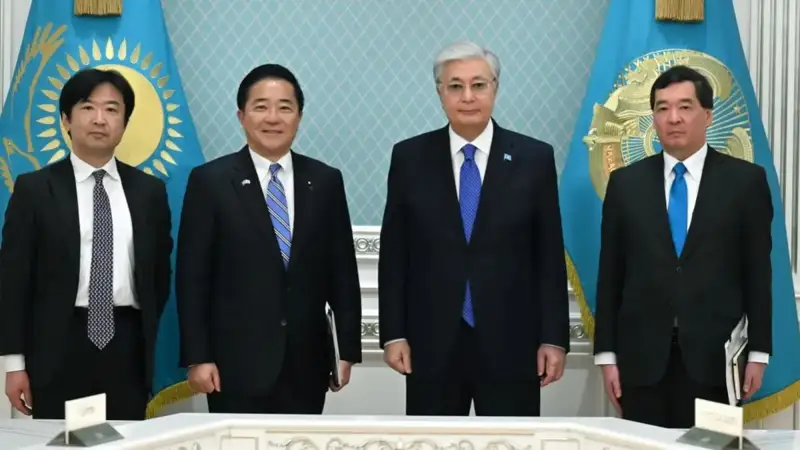 The Trump administration must keep the U.S. a player in the region.
The Trump administration must keep the U.S. a player in the region.
Developing a new strategic approach to Central Asia is probably at the bottom of the Trump administration's foreign policy inbox. Not so in Moscow, Beijing, Tehran, Kabul, Tokyo, Ankara and Brussels. This region, made up of the five "stans," is rapidly becoming an area of economic cooperation and strategic competition among America's friends and foes alike in what some have called a modern version of the 19th Century Great Game. The region sits squarely in the middle of the Eurasia heartland. It is time for the United States to pay attention.
Central Asia itself is in transition, with all the inherent political risk. Uzbekistan has a new president after 25 years of authoritarian rule by the late Islam Karimov. Kazakhstan's President Nursultan Nazarbayev is aging and has ruled since 1989 with no apparent plans for a succession. Presidential elections later this year in Kyrgyzstan will test the turbulent history of democracy there. Turkmenistan appears near the bottom of the Freedom House "Freedom in the World" index and faces instability along its border with Afghanistan. Tajikistan, the poorest and most energy-deprived of the five, is vulnerable to Taliban incursions from Afghanistan. Low commodity prices and declining remittances from guest workers in Russia threaten economic growth and political stability throughout the region.
The principal major power dynamic in Central Asia is between China and Russia. It remains to be seen the degree to which this dynamic benefits the people of Central Asia.
The region is key to China's global economic plan. Beijing's "One Belt One Road" policy is designed to secure maritime routes along the South China Sea and new land routes consisting of railways and energy pipelines traversing a new Silk Road route through Central Asia. The national sovereignty of others is being challenged along both routes. The One Belt One Road plan is designed to connect China to the rich oil and gas deposits around the Caspian Sea and to lucrative markets in Europe. In the process, China has become the major investor and trader in Central Asia. The China-led Shanghai Cooperation Organization and Asian Infrastructure Investment Bank are designed in large measure to facilitate this plan.
Moscow resists Chinese incursions into this former Soviet space when it can but accepts them when it must. Russia's vital interests in Central Asia are profound, from the historic to the demographic. More than 4 million of the region's 65 million people are ethnic Russian, most living in Kazakhstan, creating the fear among some that Russia, as in the cases of Georgia and Ukraine, will use military force to "protect" them. Russia has long wanted to reabsorb the region. But it is not working out that way. Russia's Eurasian Economic Union has failed to bind Central Asia to Russia, so it has supported efforts to link its EEU with China's Asian Bank. A default arrangement exists under which China has the major power lead in Central Asia on economic issues and Russia still dominates there in security and political matters.
Others also take a renewed interest in the region. Afghanistan's plans to tap into energy sources in Central Asia are proceeding apace. Iran, freed from most sanctions, has made the region a foreign policy priority, seeking cultural advantages from the region's Persian roots. Ankara benefits economically from development of the southern corridor of the new Silk Road and has ties through its historical origins and the Turkic language. Japan has invested heavily in energy development, particularly in Uzbekistan and Turkmenistan. Europe will benefit significantly as the railroad link from China through Central Asia transports goods more rapidly than the maritime alternative.
The United States has had some success in pursuing its two principal strategic interests in the region during the past decade. Central Asia hosted U.S. facilities to transit personnel and material to supply the war in Afghanistan. And through the provision of limited military assistance, the U.S. has contributed to maintaining the region's sovereignty and independence from Russia. Nonetheless, its success with democracy building in the region has been quite limited. As U.S. military operations in Afghanistan wind down and foreign aid grows scarce, it is fair to ask whether the U.S. still has interests and potential influence in the region.
The new global importance of the region provides the answer: yes to both. Central Asia is becoming the main land bridge between Europe and Asia. Secretary of Defense James Mattis, as a former CENTCOM commander, will understand the strategic value of the region. And Secretary of State Rex Tillerson, with his private sector experience in the energy industry, can provide insights into critical investments that will provide influence.
Efforts to overtly counter either Russian or Chinese influence could require investments that are not available. But the U.S. needs to be a player in this increasingly critical crossroads of Eurasia. So the United States might best influence events there by seeking to promote regional economic growth and political independence. It can do so by creatively using the so-called C5+1 meeting format for diplomacy, by investing in the region's energy production and transit routes using the U.S. private sector and by using U.S. military assistance to support defense reform. As a first step, however, the Trump administration needs to undertake a strategic review of America's interests and opportunities in the region.
Timothy Fairbank and Hans Binnendijk
www.usnews.com, 30.03.2017




